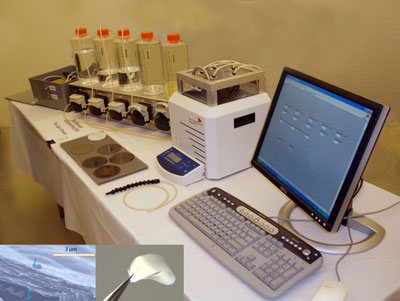ME 450 students received the prestigious 2009 R&D 100 Award for their work in the Capstone Design and Manufacturing course. The winners are four former ME undergraduates, Matt Bachner, Yeh-Chuin Poh, Tom Serbowicz, and Steve Vozar, and four co-advisors, Chemical Engineering Professor Nick Kotov, Chemical Engineering PhD students Paul Podsiadlo and Ming Qin, and ME Assistant Professor John Hart. The course gave the students the opportunity to research and develop solutions to engineering design problems.
R&D Magazine’s prestigious R&D 100 Awards, dubbed the “Oscars of Invention,” recognize the 100 most technologically significant new products, processes, materials, and software developed throughout the world and introduced into the market during the past year. These advances leapfrog current technology by providing simple and elegant solutions to complex or long-standing technical problems. Awards are based on each achievement’s significance, uniqueness, and usefulness compared to competing technologies. The winning of an R&D 100 Award provides a mark of excellence that is regarded by industry, government, and academia as proof that the product is one of the most innovative ideas of the year.

The team was chosen for the award for the invention of the Spin-Grower Desktop Layer-by-Layer Assembly System, which enables rapid and automated synthesis of nanostructured thin films by spin-assisted layer-by-layer (LBL) assembly. The conventional method of LBL assembly is by dip coating, in which a substrate is immersed in a series of oppositely-charged solutions. The “Spin-Grower” system performs LBL assembly by spinning the substrate rapidly while alternating compounds are delivered one layer at a time. Layers can be created in a matter of seconds, thus reducing production times and creating the potential for thicker multilayer composites with new morphologies and properties. The system distributes multilayered thin films by centrifugal force for the creation of nanostructured materials like filtration membranes, solar cells, and batteries. This method not only allows for faster production times than the traditional dip LBL process (300 bi-layers within hours as compared to days), but the resulting materials have a higher structural order as well. The team published the results of their research in the February 2009 issue of Review of Scientific Instruments, the most highly cited journal in instruments and instrumentation, in a paper titled “Automated spin-assisted layer-by-layer assembly of nanocomposites.”
Due to the interest shown by other research groups around the world, the team has partnered in a start-up company called Absolute Nano to produce and supply the Spin-Grower for laboratory use in both academia and industry. The company also markets the SabreTube Desktop Thermal Processing System, a unique tool for rapid development and testing of chemical vapor deposition and thermal annealing processes, such as growth of nanotubes and nanowires, curing of thin films, and thermal processing of microfabricated devices. The SabreTube was co-invented by Hart and was the winner of the 2008 R&D 100 Award.